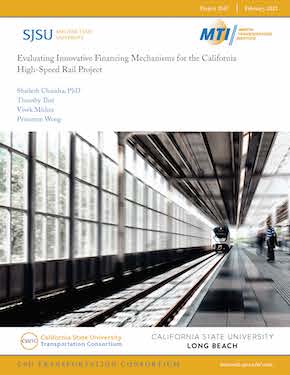- 408-924-7560
- mineta-institute@sjsu.edu
- Donate
Evaluating Innovative Financing Mechanisms for the California High-Speed Rail Project
Millions of dollars are involved in high-speed rail (HSR) infrastructure construction and maintenance. Large-scale projects like HSR require funding from a variety of avenues beyond those available through public monies. Although HSR serves the general public’s mobility needs, any funds (whether State or Federal) flowing from the public exchequer usually undergo strict review and scrutiny. Funds from public agencies are always limited, making such traditional financing mechanisms unsustainable for fulfilling HSR’s long-term operational and maintenance cost needs—on top of initial costs involved in construction. Therefore, any sustainable means of financing HSR projects would always be welcome. This research presents an alternate revenue generation mechanism that could be sustainable for financing HSR’s construction, operation, and maintenance. The methodology involves determining key HSR stations, which, after development and improvement, could significantly add value to businesses and real estate growth. Any form of real estate taxes levied on properties surrounding such stations could substantially support the HSR project’s funding needs. In this research, a bi-objective optimization problem is posed in conjunction with a Pareto-optimal front framework to identify those key stations. With 28 California HSR stations used as an example, it was observed that the four proposed HSR stations in Fullerton, Millbrae-SFO, San Francisco Transbay Terminal, and San Diego would be excellent candidates for development. Their development could increase the economic vitality of surrounding businesses. The findings could serve as valuable information for California HSR authorities to focus on developing key stations that would generate an alternate funding source for an HSR project facing funding challenges.
SHAILESH CHANDRA, PhD
Dr. Chandra is an associate professor in the Department of Civil Engineering and Construction Engineering Management at California State University, Long Beach (CSULB). He obtained his MS and PhD in civil engineering from Texas A&M University in 2009 and 2012, respectively. Dr. Chandra has more than twelve years of experience in transportation research focused on transport connectivity, transportation economics, accessibility, urban freight, and sustainability. He has been a principal investigator (PI) for several projects funded by various transportation agencies including the California Department of Transportation (Caltrans) and the United States Department of Transportation (USDOT).
TIMOTHY THAI
Mr. Thai is an undergraduate student in the Department of Civil Engineering and Construction Engineering Management at CSULB. His research interests include railroad crossings and real estate analysis.
VIVEK MISHRA
Mr. Mishra is a graduate student in the Department of Computer Science and Computer Engineering at CSULB. His research interests relate to computer programming and transportation analysis.
PRINCETON WONG
Mr. Wong is an undergraduate student in the Department of Computer Science and Computer Engineering at CSULB. His research interests relate to blockchain technology, computer programming, and transportation.
-
Contact Us
San José State University One Washington Square, San Jose, CA 95192 Phone: 408-924-7560 Email: mineta-institute@sjsu.edu






